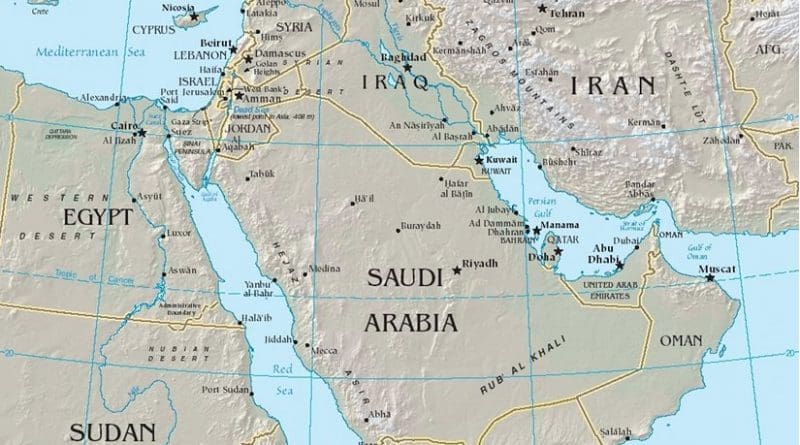Russia’s Strategic Pivot To The Middle East 2015 – Analysis
By SAAG
By Dr Subhash Kapila*
Russia’s strategic pivot to the Middle East in 2015 manifested by the Russian military intervention in Syria arises not only from Russian imperatives to bolster President Assad’s regime in Syria but also that Russia’s strategic pivot to Asia Pacific declared in 2012 failed to take off primarily due to China complicating the Russian initiative primarily focused on Japan.
Seemingly, the Middle East offers wider scope for Russia’s assertion of its global power and influence than the Asia Pacific where it geopolitically gets hemmed-in by the US-China power tussle, the China-Japan tussle and China’s aggressiveness against Russian traditional ally, namely Vietnam. All of these Chinese power tussles referred above force Russia into indefensible siding with China and China’s brinkmanship against her neighbours—–the very nations which were essential for cultivating to act as mainstays of the Russian strategic pivot to Asia Pacific.
In the Middle East, Russia enjoys the advantage of having a large number of traditional strategic partners or strategic friends, who both in the past and now stand indebted to Russia for aid, support and supply of arms. Iran and Syria head the list as Russia’s strategic partners in the region. Russia earlier in the last decade had made strategic forays to secure footholds in Saudi Arabia and Qatar to enlarge its influence.
The Middle East is also the region where Russian geopolitical and strategic initiatives are not constrained because of clashing strategic initiatives with China, whose main focus in the Middle East is the oil-rich region of The Gulf. Despite the shrunken Russian peripheries bordering the Middle East, Russia still retains considerable clout in the Middle East bordering former Russian Republics and Middle East security has a vital bearing on Russian security.
A strong Russian strategic pivot to the Middle East therefore facilitates the realisation of President Putin’s declared foreign policy prime aim of re-emerging as an independent global power centre.
The Russian military intervention in Syria lately, ensures multiple strategic benefits to Russia reinforcing its stature and a factor to be counted in Middle East affairs. More significantly, Russia with this audacious Syrian intervention has managed to break-out of the geopolitical isolation that the United States and NATO had imposed consequent to Russia’s annexation of Crimea and intervention in Ukraine,
In terms of Russia’s stature and standing in the Middle East it has acquired a credible stature in that it has demonstrated that Russia can stand-by its strategic partners with military intervention also, if required.
Russian military intervention in Syria ostensibly directed at neutralising the ISIS military threat to Syria has not only enabled military air-strikes at critical ISIS concentrations but in the bargain has enabled Russia to direct its air-strikes also against Syrian Opposition groups battling the Syrian President Assad’s regime with the help of the CIA and Gulf monarchies. It is for this reason that American opposition to Russian military intervention is more vocal.
The Russian military intervention in Syria is also vital to ensure that Russian naval and military bases in Syria of Latakia and Tartus o the East Mediterranean littoral are not endangered. Reports suggest that Russian Army troops have also been flown-in at these two locations. Tartus is the prime facility for the Russian East Mediterranean naval presence including a floating dock for repair and maintenance of Russian Navy ships.
The Russian military intervention also is a geopolitical signal to the United States and its allies in the region that Russia stands committed to continuance of the Assad regime in Syria and that if a regime-change at all becomes necessary, it will not be on terms of the Syrian Opposition aided by CIA to call the shots. In other words if a regime-change, if at all, is considered, then it will have to be a Russia-friendly regime in Damascus.
With its Syrian military intervention, Russia has ensured that the Russian-backed Middle East Northern Tier comprising Iran, Syria and Lebanon indirectly, is not unravelled by the United States and its Arab allies, by toppling the Assad regime in Syria.
Surprisingly, not much is in evidence in terms of China’s reactions to Russian military intervention in Syria whether in support or if any muted opposition. Presumably, since China is only interested in Gulf oil, it would refuse to be drawn into any reactions elsewhere in the Middle East.
Concluding, it needs to be observed that the strategic pointers are that in comparison to the Asia Pacific it is the Middle East which will be the cynosure of Russia’s strategic priorities. Russia has seemingly forced the United States and NATO in a corner in the Middle East and making them realise that Russia cannot be side-lined Middle East strategic calculus.
*Dr Subhash Kapila is a graduate of the Royal British Army Staff College, Camberley and combines a rich experience of Indian Army, Cabinet Secretariat, and diplomatic assignments in Bhutan, Japan, South Korea and USA. Currently, Consultant International Relations & Strategic Affairs with South Asia Analysis Group. He can be reached at [email protected]

